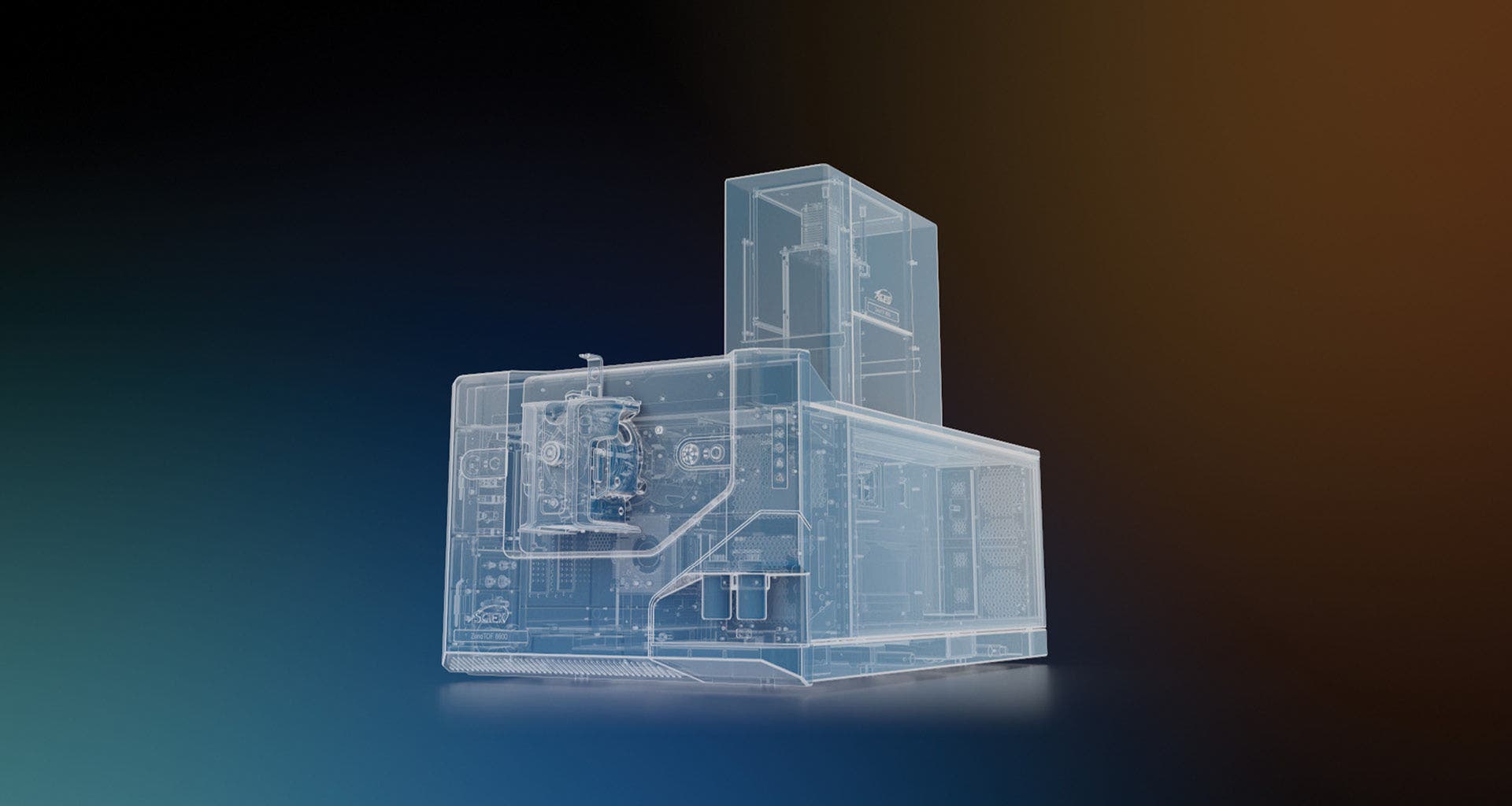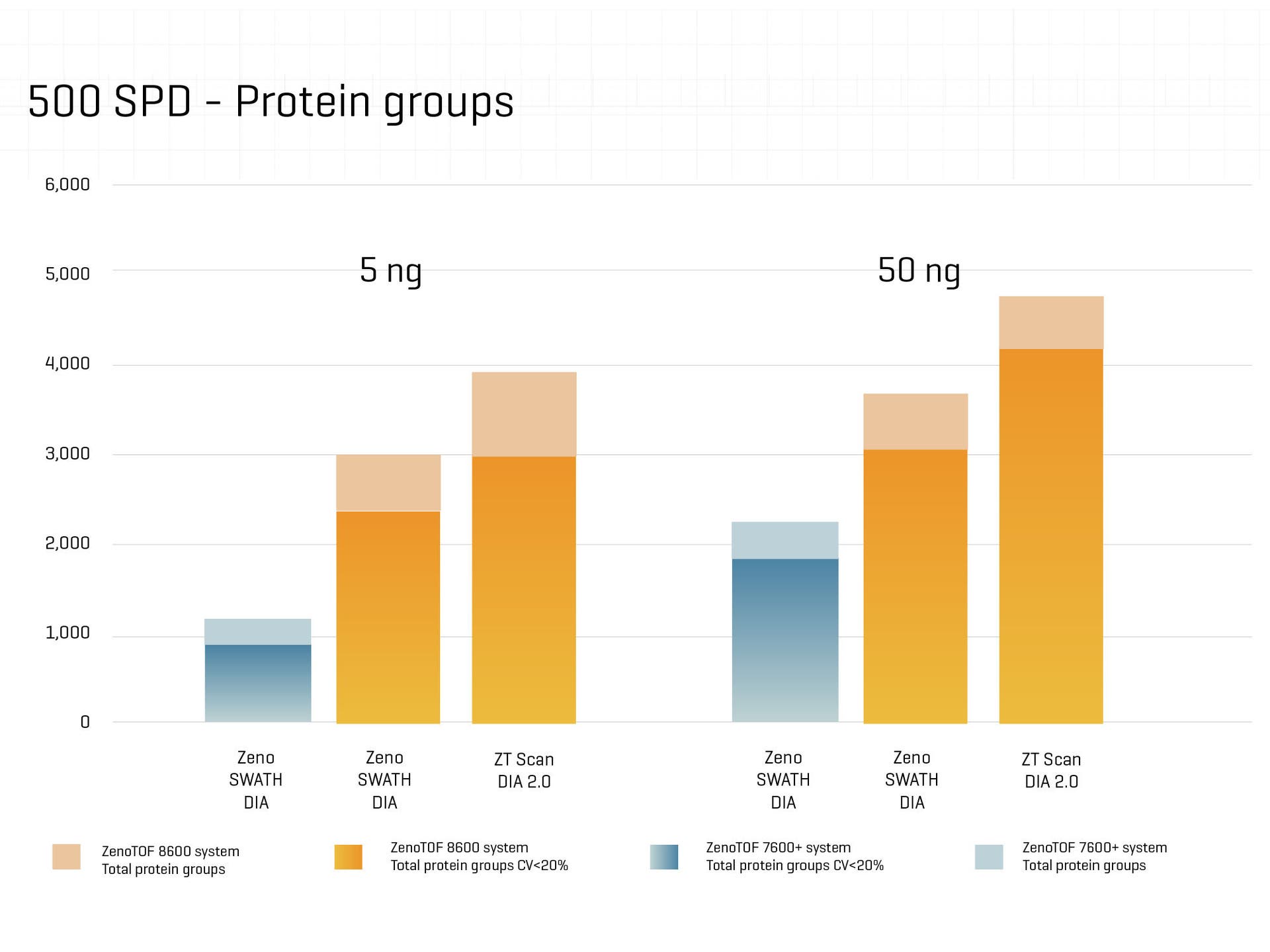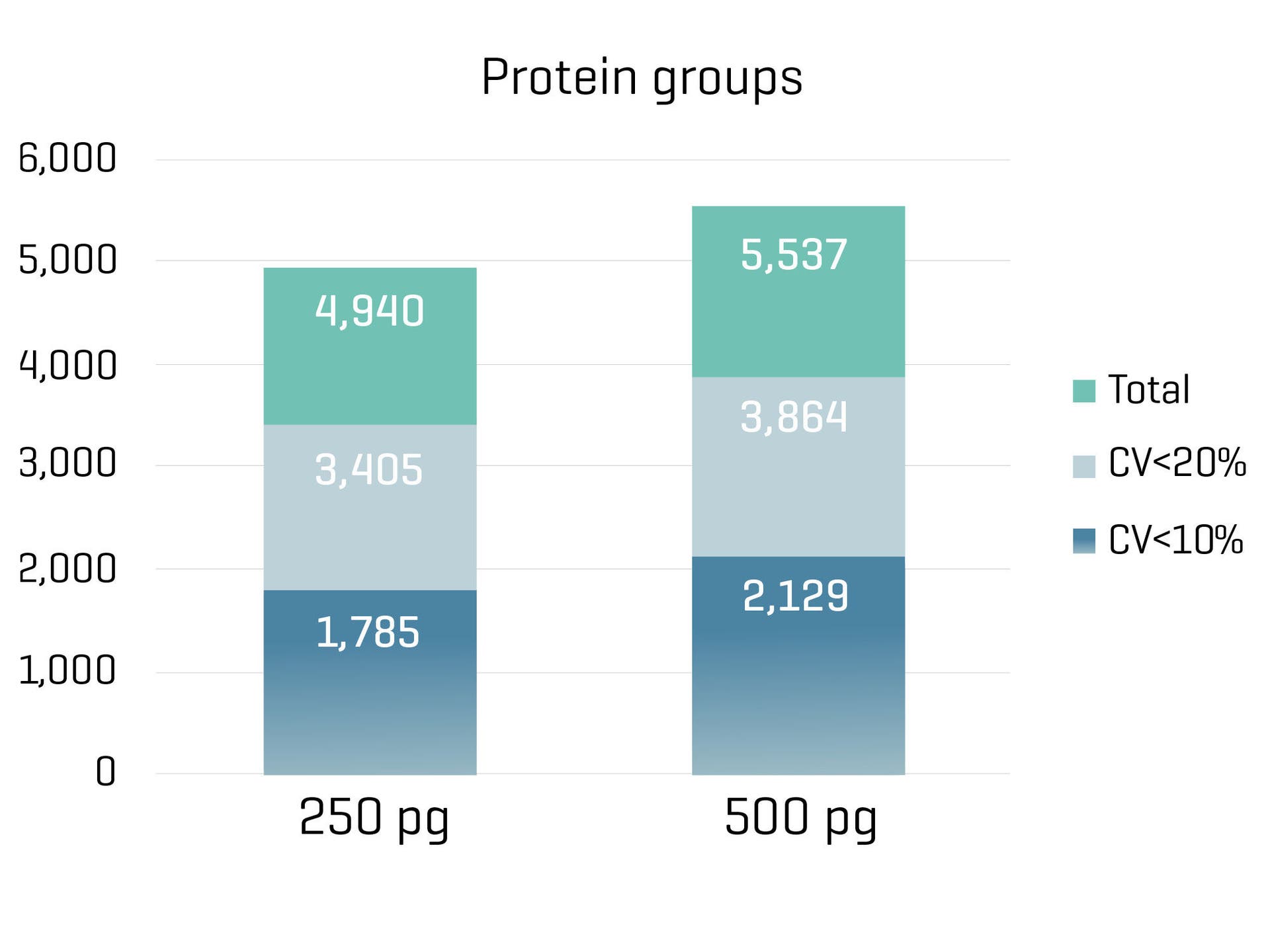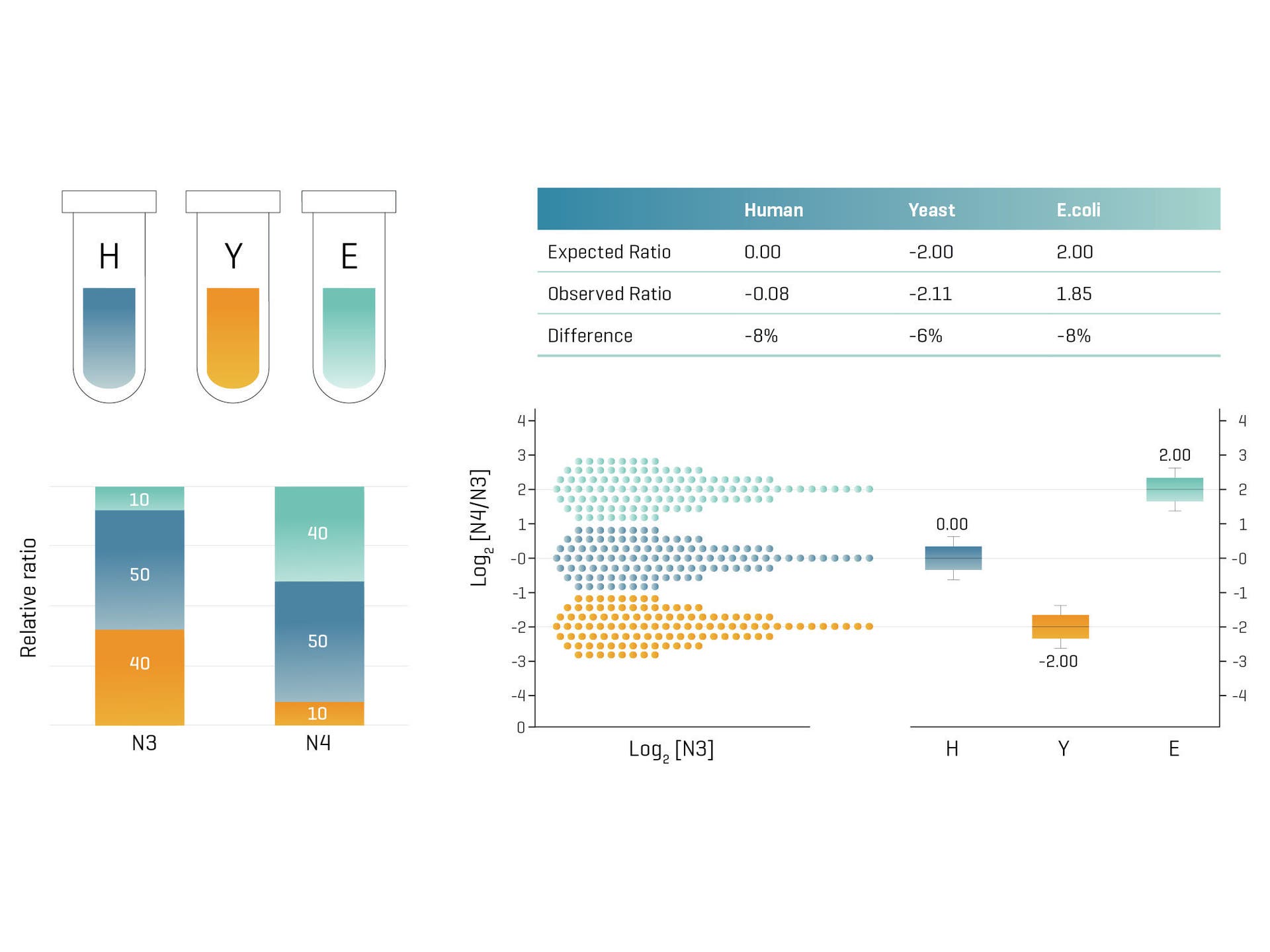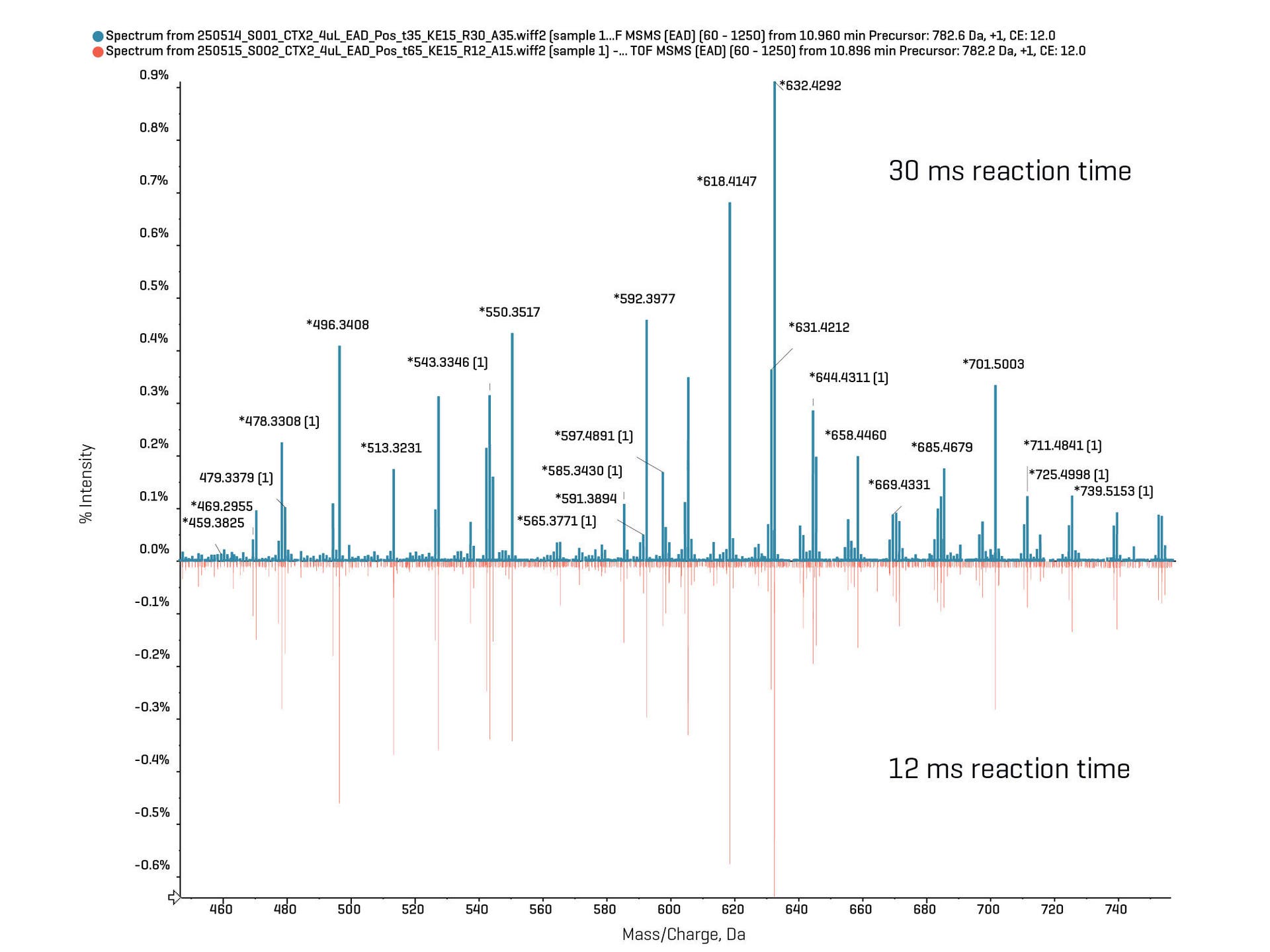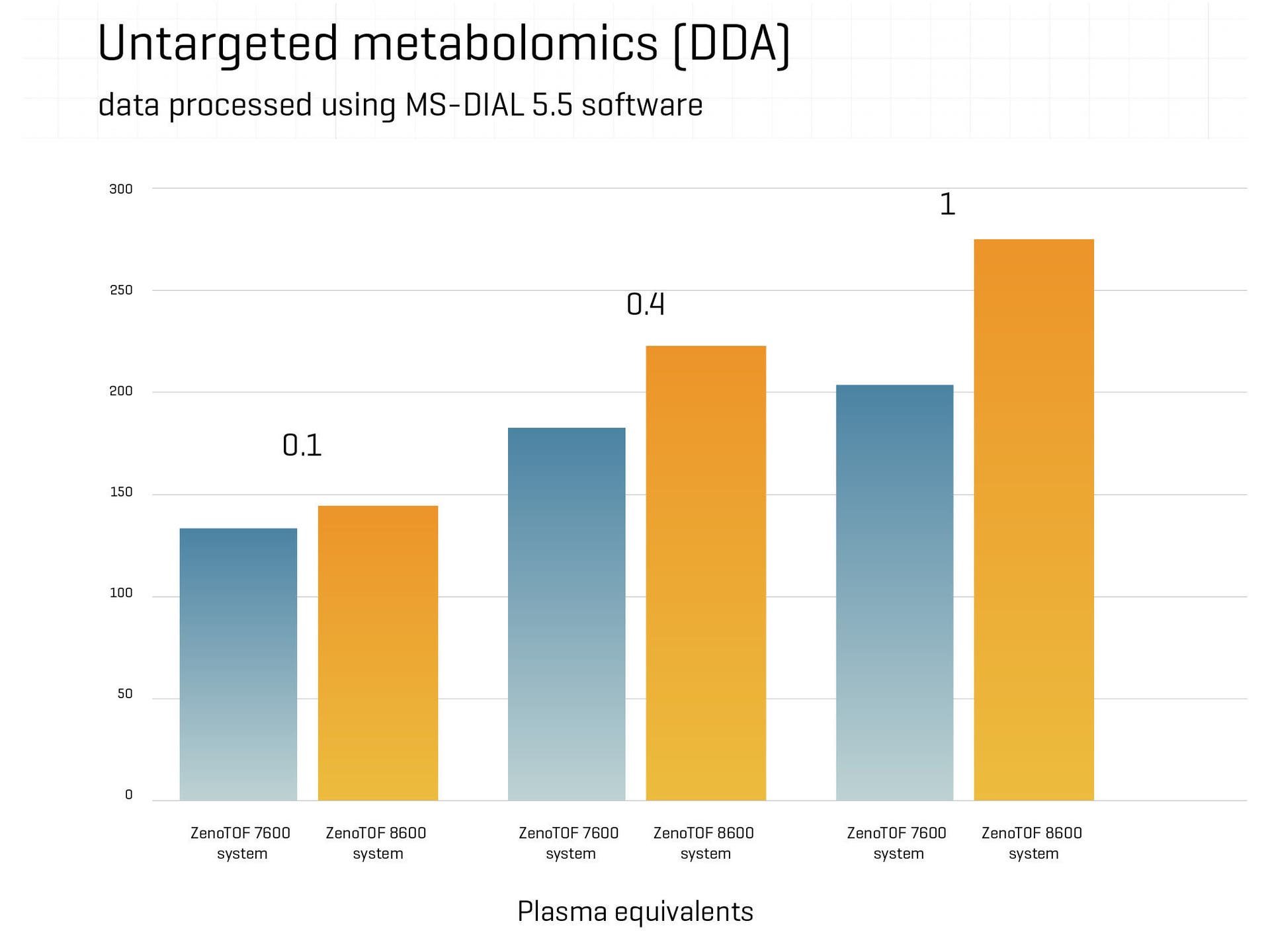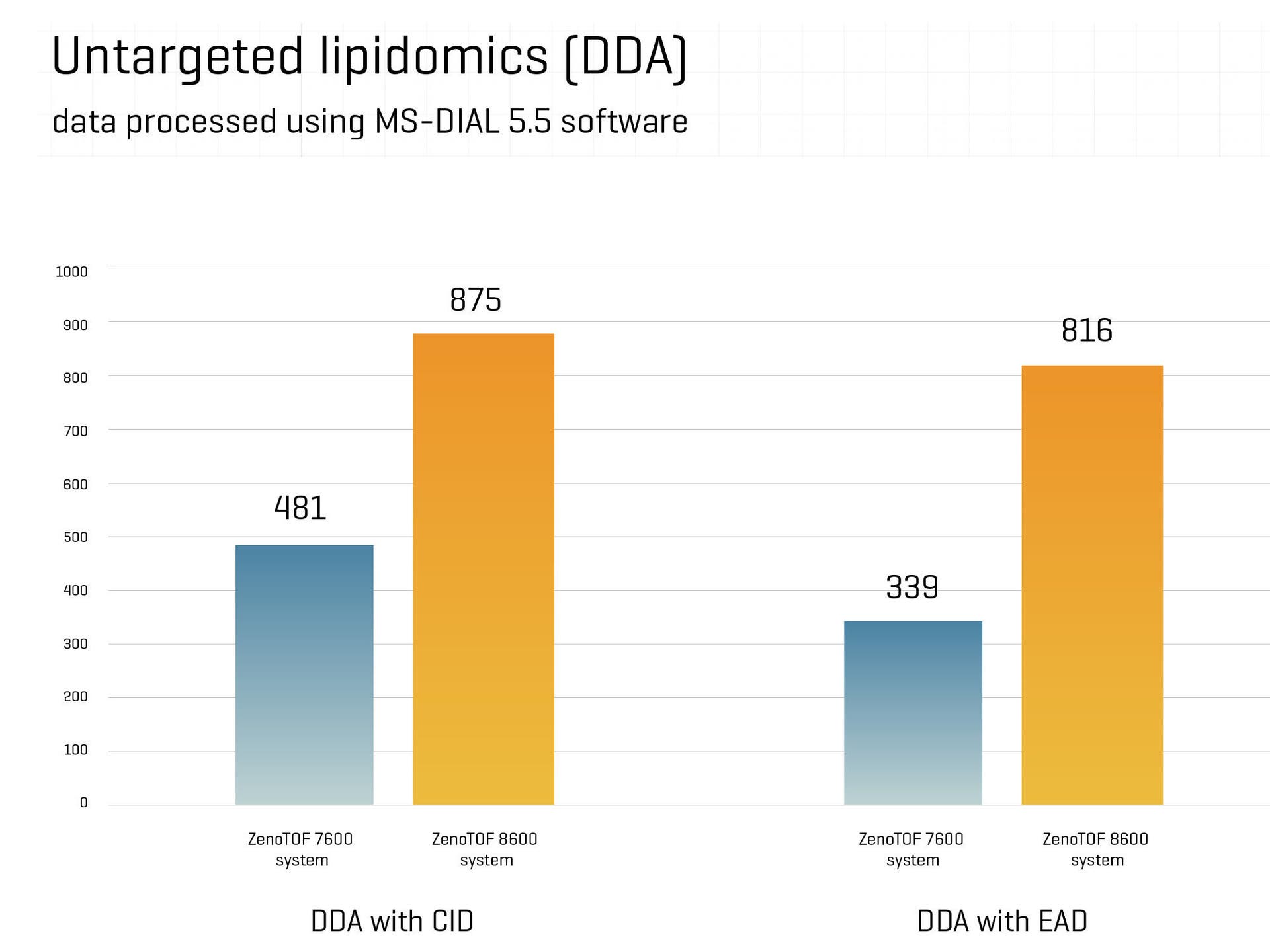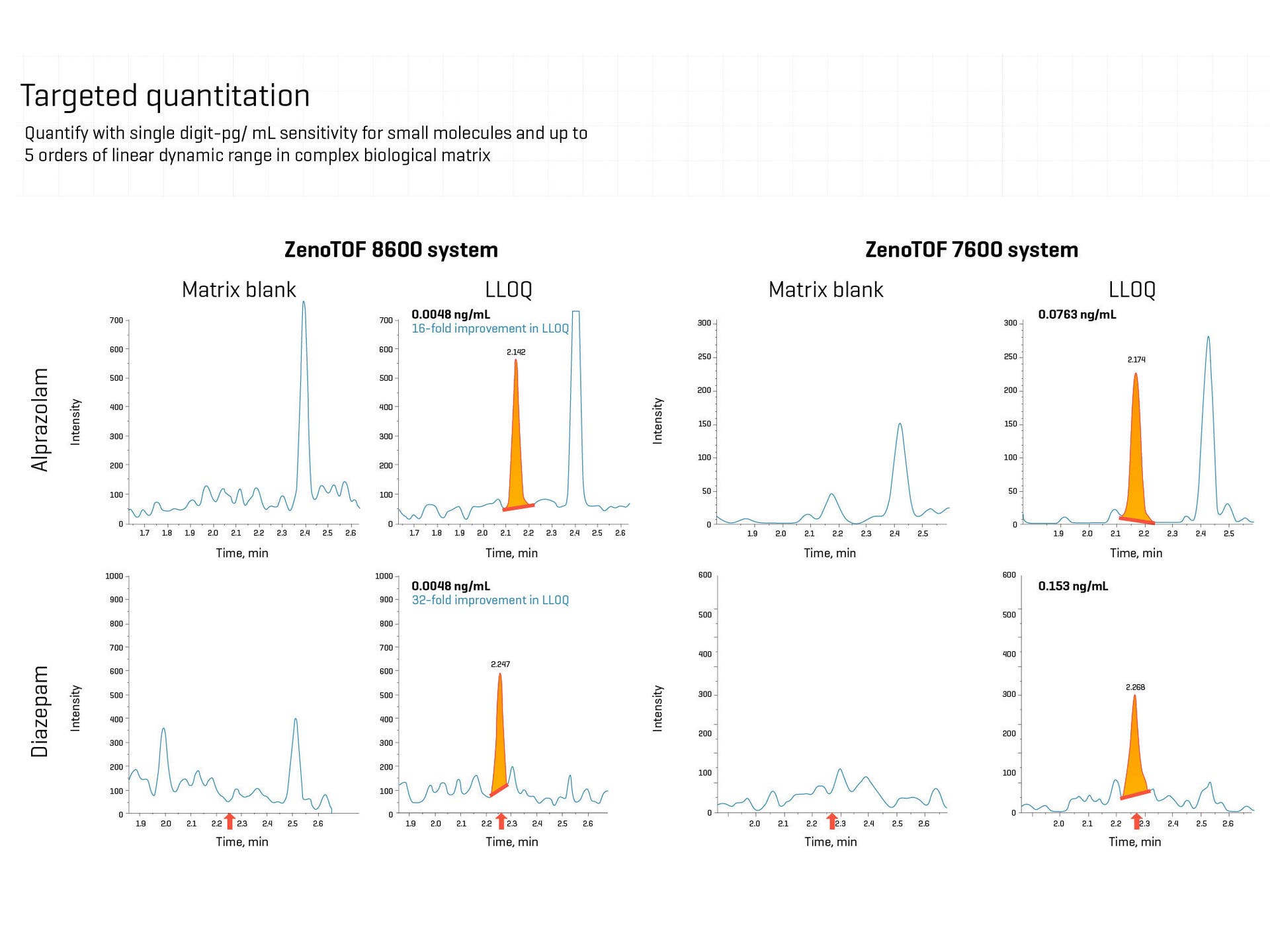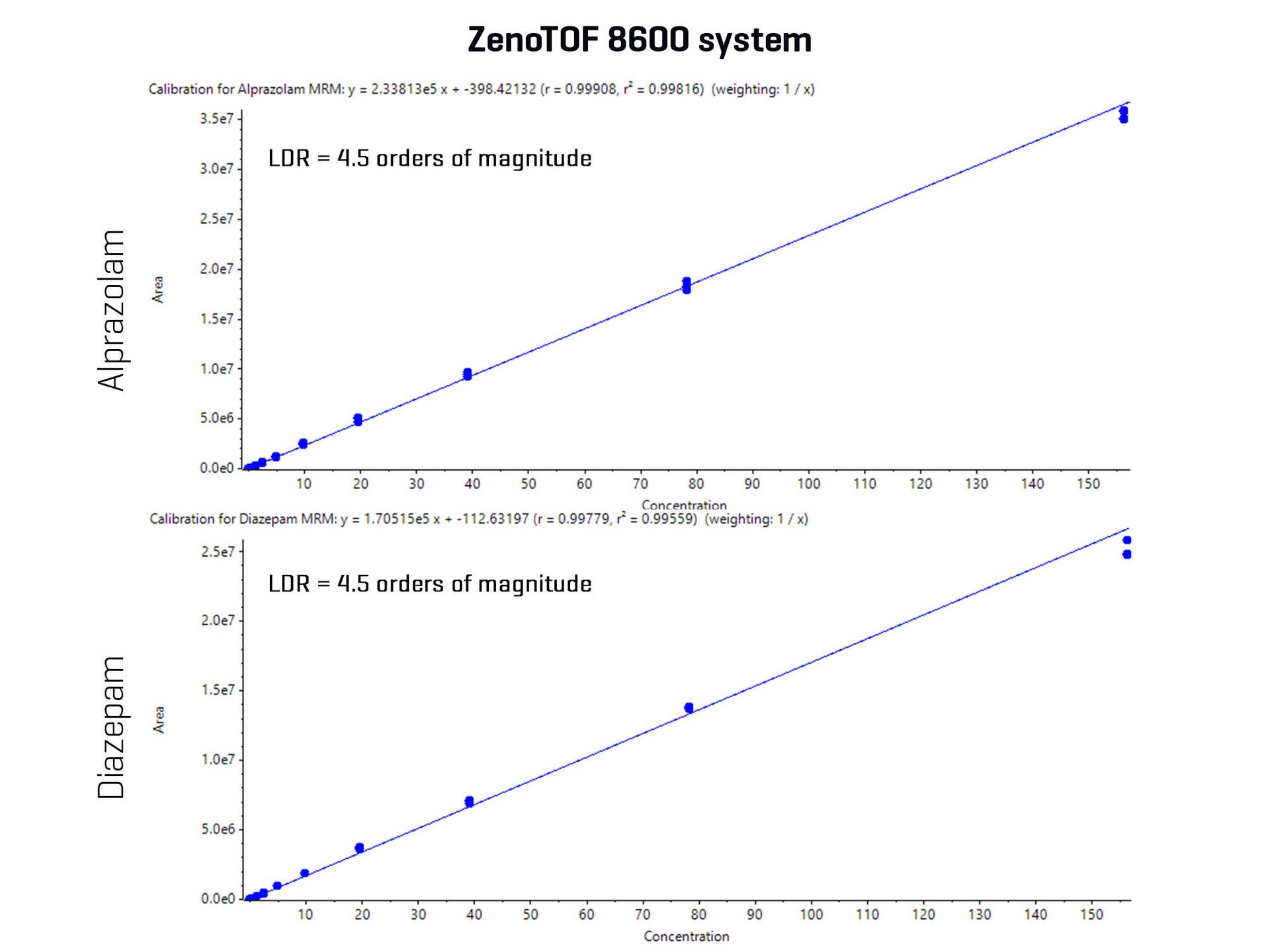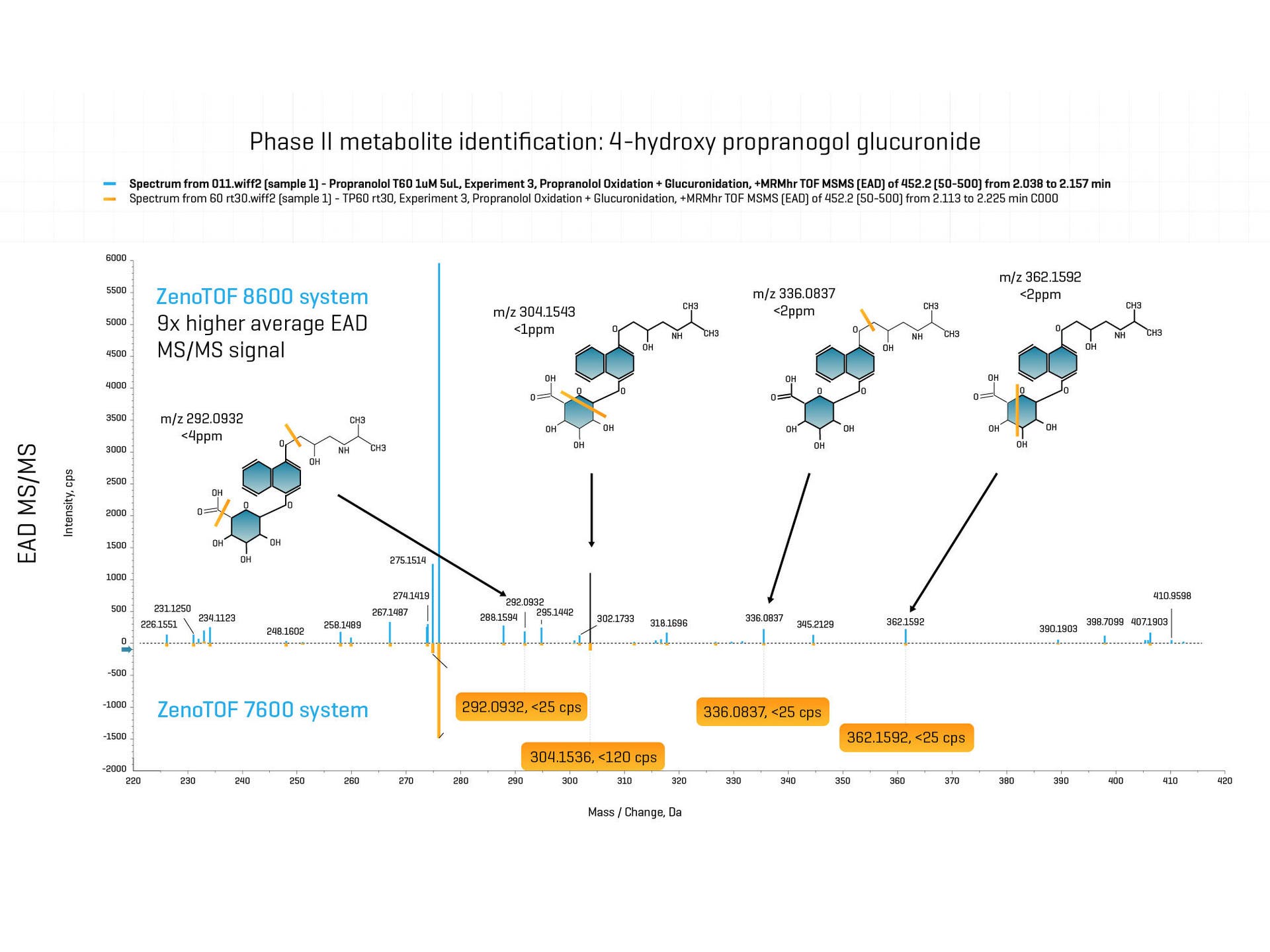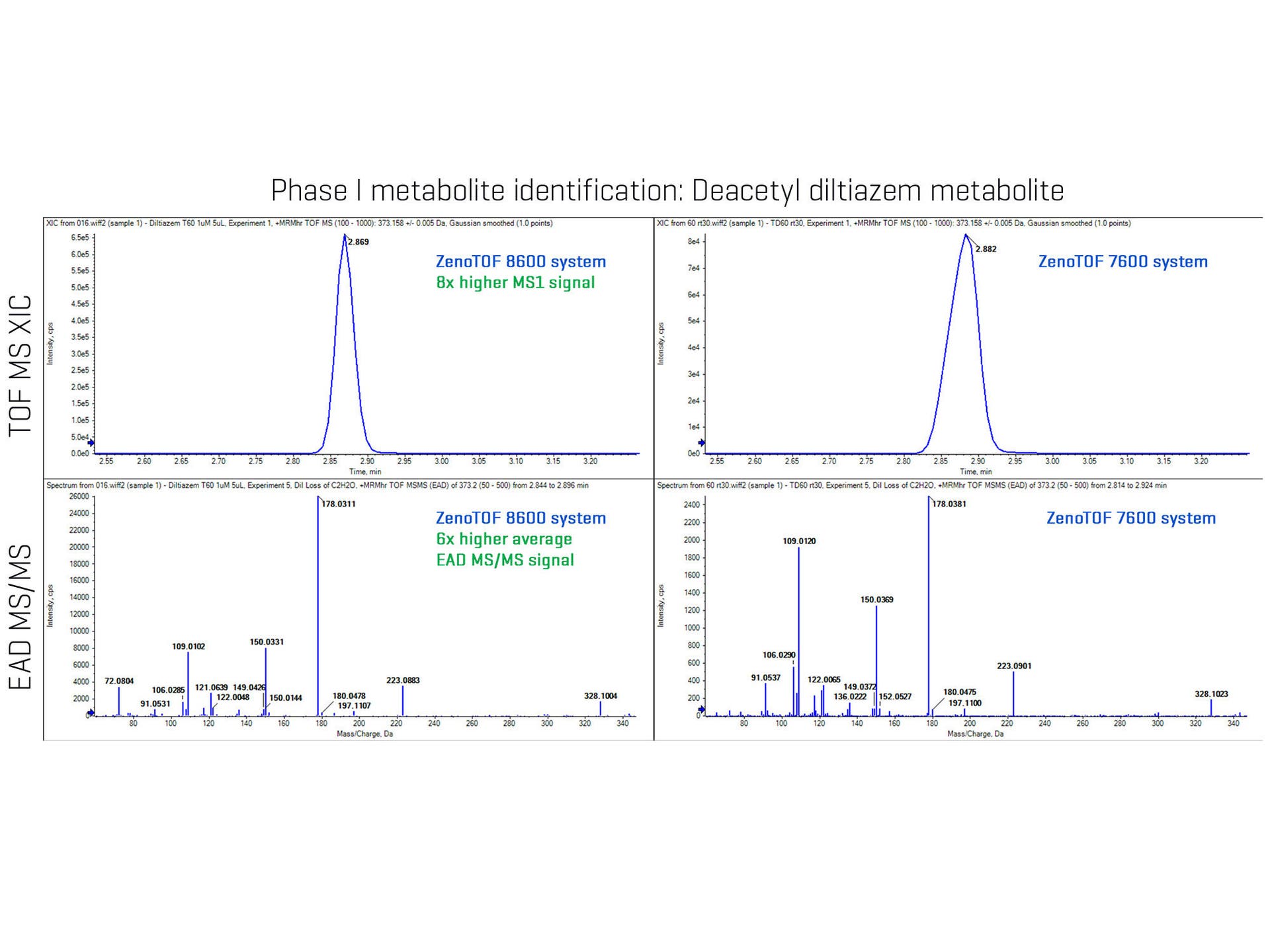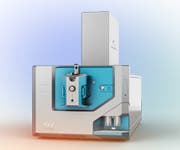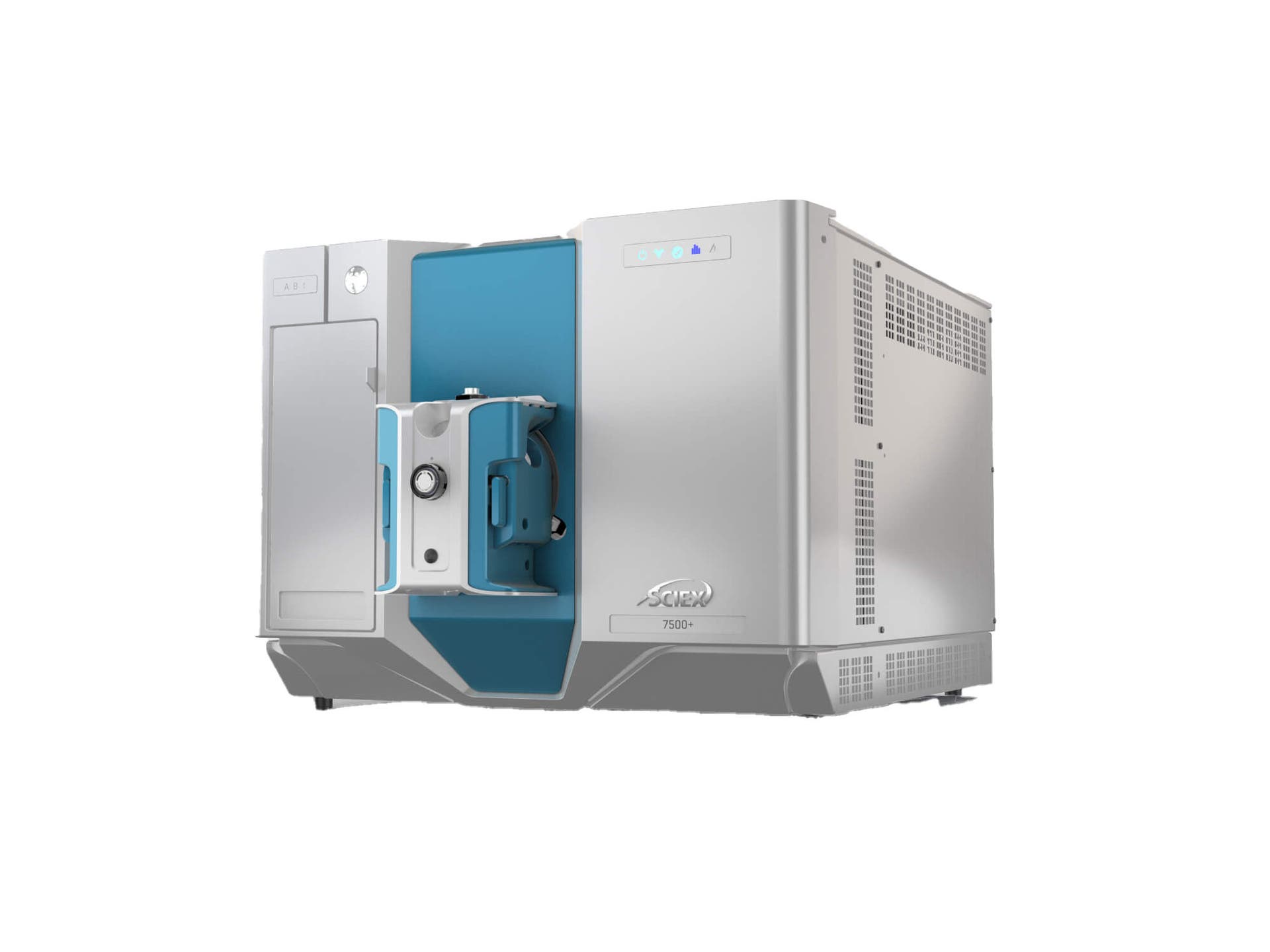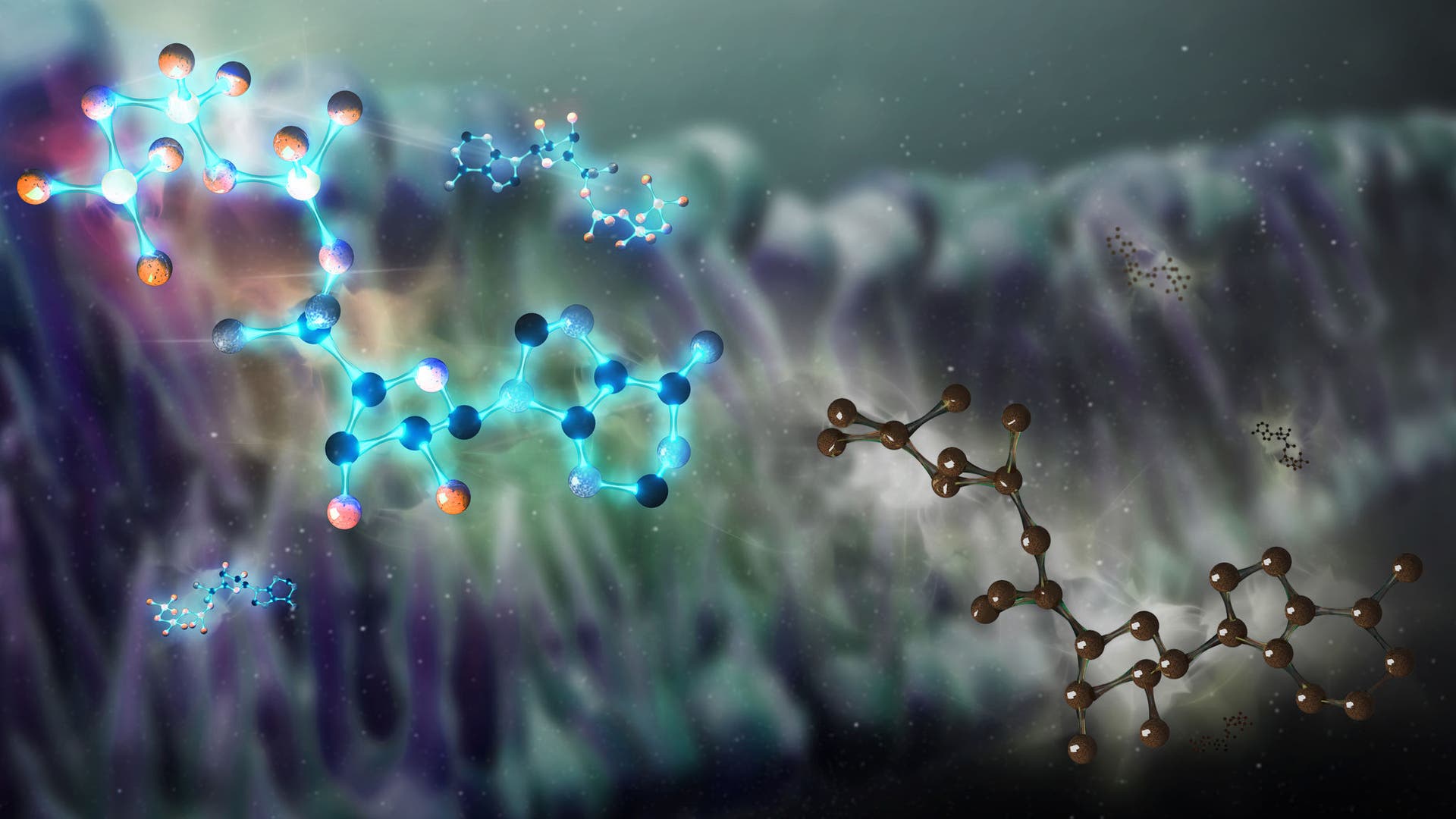The ZenoTOF 8600 system delivers new levels of sensitivity, combined with the versatility of EAD and Zeno-trap enabled workflows.
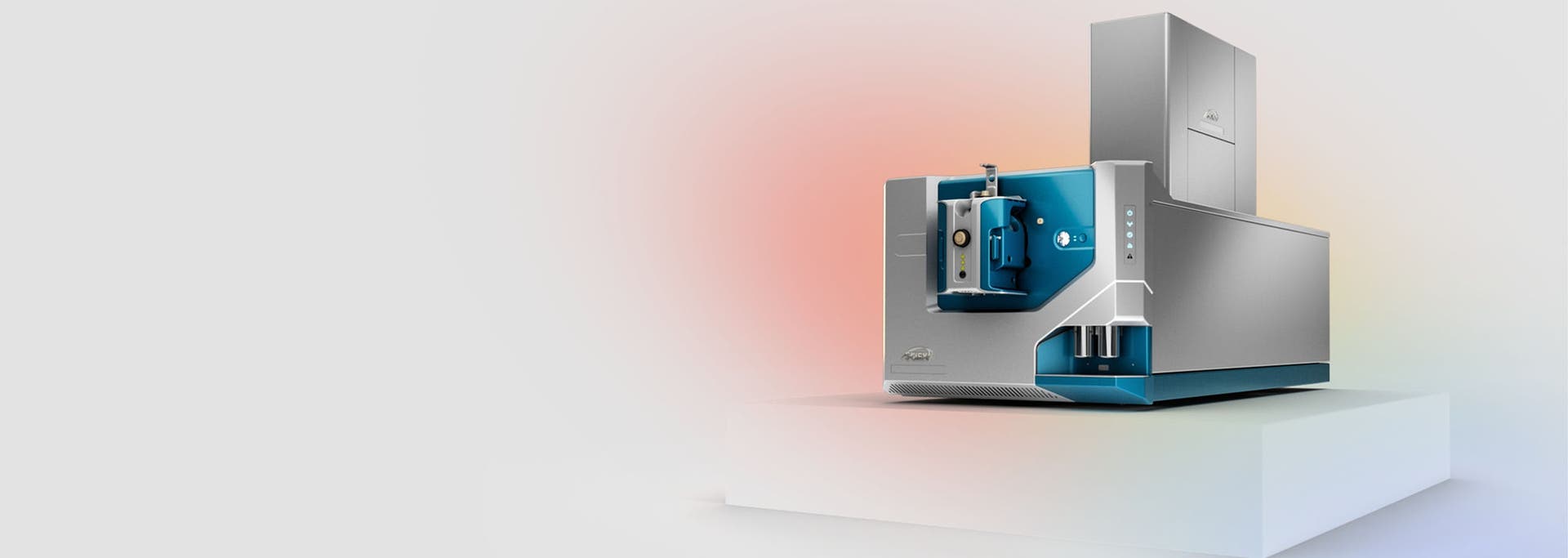
Extraordinary discoveries demand extraordinary proof
An accurate mass platform evolved from SCIEX leadership in fast, sensitive, and resilient quantitation
Welcome to the forefront of scientific innovation. In the quest to make groundbreaking biological discoveries, the quality of data and the technology used are paramount. The SCIEX ZenoTOF 8600 system combines proven technology from our most sensitive triple quad with our most versatile Zeno trap-enabled QTOF. Delivering 10x better sensitivity than the current SCIEX accurate mass system across many new and established accurate mass approaches. This translates not only into the lower limits of quantitation but also into new enabled approaches to making biologically relevant discoveries that the data can prove.
Extraordinary performance in both core and transformative workflows
The ZenoTOF 8600 system represents a leap forward in mass spectrometry, offering noteworthy sensitivity and precision. Performance that lets you do more with a single system; sensitivity and functional speed improvements in MS1 and MS2 enhance data quality across many workflows.
With 10x greater sensitivity in MS1 and MS2 and the integration of SCIEX triple quad technology, this system enables precise identification and fast, sensitive quantitation of low-abundance biomolecules across targeted, DIA, and DDA methods, achieving up to 10-fold lower LOQs and a dynamic range spanning up to 5 orders.
* Compared to the ZenoTOF 7600+ system
ZT Scan DIA 2.0 offers high-speed, broad molecule support with enhanced Q1 window selectivity for improved quantitative accuracy and identification, while its extended mass range makes it the most comprehensive and high-throughput SWATH DIA solution for all molecule types.
Sensitivity and performance-driven speed enhancements maximize throughput and enable faster acquisition of high-quality EAD spectra (extended into negative ionization with up to 50 keV), unlocking rapid data-dependent acquisition for deeper insights into lipid biology, protein modifications, and metabolite structures.
SCIEX OS 4.0 software streamlines and enhances workflows across the ZenoTOF 8600 system with innovative features for method development, real-time QC, and data acquisition, while strategic integrations with tools like PEAKS, DIA-NN, and MS-DIAL deliver optimized insights for proteomics, metabolomics, and lipidomics research.
Demand extraordinary proof
To drive new discoveries and prove biological significance, you need technology that can outperform what you currently have. You need technology that unlocks new approaches that weren’t possible before. You need quantitative data of the highest quality; data you can stake your reputation on. Discover how this advanced system can help elevate your research, providing the robust data you need to drive new discoveries and prove biological significance.
Demand more than protein identification
The application of proteomics in the real world doesn’t stop at identification. With 10x more sensitivity at your convenience*, you can take your research beyond protein ID, uncovering provable biological insights using innovative approaches to quantitative and structural proteomics.
Quantify everything you identify with precision using ZT Scan DIA 2.0, and with 10x more sensitivity*, extend your capacity into low cell number research. Now even small fold changes to be discovered and verified credibly.
* Compared to the ZenoTOF 7600+ system
Using ZT Scan 2.0 DIA resulted in further gains in identifications compared to using Zeno SWATH DIA. ZT Scan 2.0 DIA enables gains in quantitative identifications for precursors and protein groups of >5-fold and >3-fold, respectively.
Identify up to 2.5x more proteins at low loads of just 250pg* with Zeno SWATH DIA. The ability to identify and reliably quantify over 4900 proteins from 250pg of K562 cell lysate opens the door for low cell number research that can uncover nuanced biological insight.
The ZenoTOF 8600 system enables accurate quantitation of 3 individual proteomes in a 3 species mix, with values measured to within 8% of the expected.
The proof to confidently assign biological significance across the metabolome
Breaking down the complexity of the metabolome demands unambiguous data. With 10x more sensitivity across scan modes*, you can confidently identify and quantify more metabolites with a higher degree of precision, enhancing data correlation to phenotype.
Detect, differentiate, and quantify low-abundance metabolites and lipids with a 10x sensitivity increase in MS1 and MS2 compared to existing SCIEX accurate mass technology.
* Compared to the ZenoTOF 7600+ system
For singly charged molecules, a 30 ms reaction time was previously required, but now almost identical results can be achieved at 12 ms. This affords EAD to be run at CID rates, collecting more MS/MS per cycle.
Using traditional CID-based DDA approaches, reference-matched metabolite IDs are boosted by up to 1.4x and lipids by up to 1.8x, with significantly higher signal-to-noise ratios.
With up to 2.4x as many lipid structural annotations*, you can identify and annotate more lipids at the fatty acid, positional isomer, double bond position, and stereochemistry levels.
Sensitive quantitation that stands up to scrutiny
Accurate mass quantitation is no longer a compromise. With the ZenoTOF 8600, expect extraordinary performance across a suite of versatile quantitation approaches. Enhanced sensitivity unlocks faster and more comprehensive quantitative approaches. Perform quantitation using a variety of targeted and untargeted acquisition modes, giving you multiple ways to achieve scale, selectivity and sensitivity in quantitative assays.
Up to 10x lower limits of quantitation* in targeted assays, delivering single digit-pg/ mL sensitivity for small molecules and digit-femtomolar on-column sensitivity for peptides with up to 5 orders of linear dynamic range in complex biological matrix.
* Compared to the ZenoTOF 7600+ system
Alprazolam, diazepam and trimethoprim showed a 16-, 32- and 8-fold improvement in LLOQ, respectively, compared to the ZenoTOF 7600 system.
Accurate quantitative performance was achieved with %CV <13% at all concentration levels across a wide linear dynamic range (LDR) of up to 4.5 orders of magnitude.
Compelling evidence that eliminates uncertainty in metabolite ID
Significant biological effects can extend beyond in-vitro measurements. 10x sensitivity across MS1 and MS2* enables the identification and quantitation of low level circulating drug metabolites, bringing an enhanced understanding of drug safety and efficacy to drug development.
Confidently differentiate the sites of metabolism and precisely track minor biotransformations in circulating metabolites. Identify more biotransformations and increase structural certainty with the localization of more sites of metabolism*.
* Compared to the ZenoTOF 7600+ system
Enhanced EAD MS/MS sensitivity for phase II metabolite identification. 4-hydroxy propranolol glucuronide metabolite demonstrated a 9x greater average EAD MS/MS signal improvement. A set of 4 unique EAD fragments were confidently identified using the ZenoTOF 8600 system with the increased EAD MS/MS sensitivity.
Improved MS1 and EAD MS/MS sensitivity for phase I metabolite identification of deacetyl diltiazem metabolite. Deacetyl diltiazem demonstrated an 8x higher MS1 signal and a 6x greater average EAD MS/MS signal on the ZenoTOF 8600 system than on the ZenoTOF 7600 system.
Features
Attaching biological relevance to discoveries in your research demands the highest possible data quality and the ability to harness new technology in unprecedented ways.
Ionization source
The OptiFlow Pro ion source incorporates the reliability and efficiency of the Turbo V ion source while providing flexibility for quickly switching flow rates.
Scan speeds of up to 858 Hz
The fastest SCIEX QTOF yet! When using ZT Scan DIA 2.0, the isolation window for MS/MS slides along the m/z range of interest during each cycle. With a quadrupole scan speed of up to 4000 Da/s, the system can operate at a MS/MS scan rate of up to 858 Hz, dependent on the pre-defined mass range, (not accounting for multiple precursors in a single isolation encoded window).
Mass Guard technology with optical detector
The novel combination of Mass Guard technology and a new optical detection system allows the instrument to operate effectively at higher ion currents while protecting it from contamination.
ZT Scan 2.0 DIA for all molecule types
The flexibility in mass range and compound parameters extends functionality across diverse workflows, including small molecule analysis. Methods are easy to set up and require minimal user optimization, facilitating the analysis of large sample cohorts.
High-energy EAD
Acquire higher-quality EAD spectra faster across all molecule types*. Perform CID or EAD profiling on equivalent timescales, gaining deeper insights into lipid biology, protein modifications, and metabolite structures. Extend electron-based fragmentation capabilities into negative ionization with up to 50 eV.
ZenoTOF versatility
Zeno trap can be enabled to deliver enhanced sensitivity. Ions are accumulated in the Zeno trap before being pulsed rapidly into the TOF, meaning we can detect up to 20x more ions than a classical QTOF design.
Integrated innovation
SCIEX OS 4.0 software enables users to track instrument performance, instrument health and enhanced automated system tuning, helping to ensure that users can easily attain and maintain optimum performance from their system.
More energy efficient
The ZenoTOF 8600 system uses dry roughing pumps, which can reduce electricity consumption by up to 24% relative to oil-sealed pumps.
Related products
A high-resolution mass spectrometry solution that combines powerful MS/MS sensitivity, fragmentation technology and a step-change in data independent acquisition.
The SCIEX ZenoTOF 7600+ system is a Zeno trap-enabled QTOF engineered with the added specificity of the scanning quadrupole dimension to enhance speed, depth and certainty in quantitative measurements.
Setting a new standard for instrument resilience and robustness, the SCIEX 7500+ system gives you the confidence to face evolving analytical challenges. Tackle tight timelines with exceptional sensitivity and with the power to control your instrument downtime.
Related applications
Resources
-
Technical note
Enhanced sensitivity and quantitative performance featuring a novel quadrupole time of flight mass spectrometer
The ZenoTOF 8600 system was utilized to quantify peptides in a complex biological matrix, achieving single-digit femtomolar on-column sensitivity and up to 5 orders of linear dynamic range.
-
Technical note
Transforming small molecule quantitative sensitivity with a novel quadrupole time-of-flight mass spectrometer
The ZenoTOF 8600 system was utilized to quantify small molecules in a complex biological matrix, achieving single-digit pg/ mL sensitivity and up to 5 orders of linear dynamic range.
-
Technical note
Improved metabolite identification using the ZenoTOF 8600 system to analyze NIST SRM 1950 plasma by DDA analysis
Detect, differentiate, and quantify low-abundance metabolites with a 10x sensitivity increase in MS1 and MS2 compared to existing SCIEX accurate mass technology. Using CID-based DDA, reference-matched metabolite IDs are boosted by up to 1.4x.
-
Technical note
Improved lipid identification using the ZenoTOF 8600 system for untargeted lipidomics analysis
Detect, differentiate, and quantify low-abundance lipids with up to a 10x sensitivity increase in MS1 and MS2 compared to existing SCIEX accurate mass technology. Using CID-based DDA, reference-matched lipid IDs are boosted by up to 1.8x and using EAD-based DDA up to 2.4x as many lipid structural annotations.
-
Technical note
Advances in high-throughput quantitative proteomics powered by high-sensitivity data-independent acquisition on the ZenoTOF 8600 system
Use rapid gradients that can deliver 500 samples per day to quantify what you identify with an average %CV of 8.5 using ZT Scan DIA 2.0.
-
Technical note
Achieving deep quantitative proteome coverage from sub-nanogram sample loadings using Whisper Zoom and Zeno SWATH DIA on the ZenoTOF 8600 system
Identify and reliably quantify over 4400 proteins from 250pg of K562 cell lysate opens the door for low cell number research that can uncover nuanced biological insight.
-
Technical note
Breaking the limits: An ultra-sensitive complementary fragmentation for the confident identification and characterization of drug metabolites
An ultra-sensitive method for confidently identifying and structurally elucidating drug metabolites, leveraging the enhanced MS1 and electron-activated dissociation (EAD) MS/MS sensitivity of the ZenoTOF 8600 system.
-
Technical note
Quantitative and qualitative bile acid analysis on the ZenoTOF 8600 system using EAD
Increased sensitivity translates into faster acquisition of high-quality EAD spectra to sensitively detect, quantify, and structurally characterize the bile acid content in human plasma.
